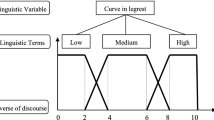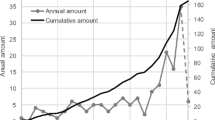Abstract
In new industrial product development, human-involvement conceptual design evaluation (CDE) is an information-intensive and multi-criteria group decision-making (MCGDM) process. To capture and formalize the uncertain information from decision-makers (DMs), several derivations of fuzzy number such as triangular intuitionistic fuzzy number (TIFN), Z-number, and interval number have been employed in CDE, which only cover limited information. The main contributions of this paper are as follows: firstly, a new kind of fuzzy number by taking advantage of TIFN, Z-number and interval number, i.e., interval intuitionistic fuzzy-Z-number (IIFZN), is presented to utilize DM’s preference value (PV) for alternative, as well as his important rating (IR) and familiarity degree (FD) judgements for evaluation criterion. IIFZN is composed of not only the membership and non-membership of PV or IR, but also the affiliated confidence coefficient transformed from FD. Then, in terms of the IIFZN-based decision-making matrix, this study proposes new ideal solution definition rules and distance measurement metric in technique for order preference by similarity to ideal solution (TOPSIS) to form a new TOPSIS-IIFZN method. The proposed method will enable DM easily find the alternative which is most preferable for important and familiar criteria and least preferred for less important and unfamiliar criteria as the best one. It is more rational than traditional PV-only CDE method, which will help company to save manufacturing resources. Besides theoretical research, one practical example and three more complex comparative experiments have been carried out to validate the performance of TOPSIS-IIFZN. By comparing with other MCGDM methods using different types of fuzzy numbers, it proves that TOPSIS-IIFZN can obtain more reasonable evaluation results. Meanwhile, besides PV, the RI and FD factors also play great influences in CDE.









Similar content being viewed by others
References
Ernawati, D., Pujawan, I.N., Batan, I.M.L., Anityasari, M.: Evaluating alternatives of product design: a multi criteria group decision making approach. Int. J. Serv. Oper. Manag. 20(3), 271–288 (2015)
Qi, J., Hu, J., Huang, H.Q., Peng, Y.H.: New customer-oriented design concept evaluation by using improved Z-number-based multi-criteria decision-making method. Adv. Eng. Inform. 53, 101683 (2022)
Qi, J., Hu, J., Peng, Y.H.: Modified rough VIKOR based design concept evaluation method compatible with objective design and subjective preference factors. Appl. Soft Comput. 107, 107414 (2021)
Qi, J., Hu, J., Peng, Y.H.: New design concept evaluation method involving customer preferences based on rough distance to redefined ideal solution. Comput. Ind. Eng. 147, 106677 (2020)
Zhu, G.N., Hu, J., Ren, H.: A fuzzy rough number-based AHP-TOPSIS for design concept evaluation under uncertain environments. Appl. Soft Comput. 91, 106228 (2020)
Tao, J., Xu, L.Y., Wang, G.X., Jin, Y.L., Yan, Y.: A knowledge-based method for rapid design concept evaluation. IEEE Access. 7, 116835–116847 (2019)
Tiwari, V., Jain, P.K., Tandon, P.: Product design concept evaluation using rough sets and VIKOR method. Adv. Eng. Inform. 30(1), 16–25 (2016)
Tiwari, V., Jain, P.K., Tandon, P.: An integrated Shannon entropy and TOPSIS for product design concept evaluation based on bijective soft set. J. Intell. Manuf. 30(4), 1645–1658 (2019)
Shidpour, H., Da Cunha, C., Bernard, A.: Group multi-criteria design concept evaluation using combined rough set theory and fuzzy set theory. Expert Syst. Appl. 64, 633–644 (2016)
Gupta, S., Soni, U., Kumar, G.: Green supplier selection using multi-criterion decision making under fuzzy environment: a case study in automotive industry. Comput. Ind. Eng. 136, 663–680 (2019)
Mohebbi, A., Achiche, S., Baron, L.: Multi-criteria fuzzy decision support for conceptual evaluation in design of mechatronic systems: a quadrotor design case study. Res. Eng. Des. 29(3), 329–349 (2018)
Vinodh, S., Balagi, T.S.S., Patil, A.: A hybrid MCDM approach for agile concept selection using fuzzy DEMATEL, fuzzy ANP and fuzzy TOPSIS. Int. J. Adv. Manuf. Technol. 83(9–12), 1979–1987 (2016)
Vinodh, S., Sarangan, S., Vinoth, S.C.: Application of fuzzy compromise solution method for fit concept selection. Appl. Math. Model. 38(3), 1052–1063 (2014)
Wang, H., Pan, X., He, S.: A new interval type-2 fuzzy VIKOR method for multi-attribute decision making. Int. J. Fuzzy Syst. 21(1), 145–156 (2019)
Akay, D., Kulak, O., Henson, B.: Conceptual design evaluation using interval type-2 fuzzy information axiom. Comput. Ind. 62(2), 138–146 (2011)
Atanassov, K.T.: Intuitionistic fuzzy sets. Fuzzy Set Syst. 20(1), 87–96 (1986)
Liao, H., Xu, Z., Zeng, X.J., Merigó, J.M.: Framework of group decision making with intuitionistic fuzzy preference information. IEEE Trans. Fuzzy Syst. 23(4), 1211–1227 (2014)
Qin, Q., Liang, F., Li, L., Chen, Y.W., Yu, G.F.: A TODIM-based multi-criteria group decision making with triangular intuitionistic fuzzy numbers. Appl. Soft Comput. 55, 93–107 (2017)
Atalik, G., Senturk, S.: A noval ranking approach based on incircle of triangular intuitionistic fuzzy numbers. J. Intell. Fuzzy Syst. 39(5), 6271–6278 (2020)
Dong, J., Wan, S.: A new method for multi-attribute group decision making with triangular intuitionistic fuzzy numbers. Kybernetes 45(1), 158–180 (2016)
Wang, C.H., Wang, J.Q.: A multi-criteria decision-making method based on triangular intuitionistic fuzzy preference information. Intell. Autom. Soft Comput. 22(3), 473–482 (2016)
Zhang, S., Meng, F.: A group decision making method with intuitionistic triangular fuzzy preference relations and its application. Appl. Intell. 51(4), 2556–2573 (2021)
Tan, C., Chung, H., Barton, K., Hu, S.J., Freiheit, T.: Incorporating customer personalization preferences in open product architecture design. J. Manuf. Syst. 56, 72–83 (2020)
Peng, H.G., Wang, J.Q.: A multicriteria group decision-making method based on the normal cloud model with Zadeh’s Z-numbers. IEEE Trans. Fuzzy Syst. 26(6), 3246–3260 (2018)
Zadeh, L.A.: A note on Z-numbers. Inf. Sci. 181(14), 2923–2932 (2011)
Aydoğan, S., Günay, E.E., Akay, D., Kremer, G.E.O.: Concept design evaluation by using Z-axiomatic design. Comput. Ind. 122, 103278 (2020)
Babroudi, N.E.P., Sabri-Laghaie, K., Ghoushchi, N.G.: Re-evaluation of the healthcare service quality criteria for the Covid-19 pandemic: Z-number fuzzy cognitive map. Appl. Soft Comput. 112, 107775 (2021)
Chai, J., Su, Y., Lu, S.: Linguistic Z-number preference relation for group decision making and its application in digital transformation assessment of SMEs. Expert Syst. Appl. 213, 118749 (2023)
Zhang, Z., Chu, X.: A new integrated decision-making approach for design alternative selection for supporting complex product development. Int. J. Comput. Integr. Manuf. 22(3), 179–198 (2009)
Lin, M.C., Wang, C.C., Chen, M.S., Chang, C.A.: Using AHP and TOPSIS approaches in customer-driven product design process. Comput. Ind. 59(1), 17–31 (2008)
Mitchell, H.B.: Ranking-intuitionistic fuzzy numbers. Int. J. Uncertain. Fuzziness Knowl.-Based Syst. 12(03), 377–386 (2004)
Xu, Z.S.: Intuitionistic preference relations and their application in group decision making. Inf. Sci. 177, 2363–2379 (2007)
Ye, F.: An extended TOPSIS method with interval-valued intuitionistic fuzzy numbers for virtual enterprise partner selection. Expert Syst. Appl. 37(10), 7050–7055 (2010)
Seikh, M.R., Nayak, P.K., Pal, M.: Notes on triangular intuitionistic fuzzy numbers. Int. J. Math. Oper. Res. 5(4), 446–465 (2013)
Yu, D.: Prioritized information fusion method for triangular intuitionistic fuzzy set and its application to teaching quality evaluation. Int. J. Intell. Syst. 28(5), 411–435 (2013)
Saeed, M., Mehmood, A., Anwar, A.: An extension of TOPSIS based on linguistic terms in triangular intuitionistic fuzzy structure. Punjab Univ. J. Math. 53(6), 409–424 (2021)
Garg, H., Kumar, K.: Improved possibility degree method for ranking intuitionistic fuzzy numbers and their application in multiattribute decision – making. Granul. Comput. 4(2), 237–247 (2018)
Wan, S.P., Lin, L.L., Dong, J.: MAGDM based on triangular Atanassov’s intuitionistic fuzzy information aggregation. Neural Comput. Appl. 28(9), 2687–2702 (2017)
Wan, S.P., Wang, F., Lin, L.L., Dong, J.Y.: Some new generalized aggregation operators for triangular intuitionistic fuzzy numbers and application to multi-attribute group decision making. Comput. Ind. Eng. 93, 286–301 (2016)
Dong, J.Y., Lin, L.L., Wang, F., Wan, S.P.: Generalized Choquet integral operator of triangular Atanassov’s intuitionistic fuzzy numbers and application to multi-attribute group decision making. Int. J. Uncertain. Fuzziness Knowl.-Based Syst. 24(05), 647–683 (2016)
Zhu, G.N., Hu, J.: A rough-Z-number-based DEMATEL to evaluate the co-creative sustainable value propositions for smart product-service systems. Int. J. Intell. Syst. 36(8), 3645–3679 (2021)
Yazdi, A.K., Komijan, A.R., Wanke, P.F., Sardar, S.: Oil project selection in Iran: a hybrid MADM approach in an uncertain environment. Appl. Soft Comput. 88, 106066 (2020)
Qiao, D., Wang, X.K., Wang, J.Q., Chen, K.: Cross entropy for discrete Z-numbers and its application in multi-criteria decision-making. Int. J. Fuzzy Syst. 21(6), 1786–1800 (2019)
Aboutorab, H., Saberi, M., Asadabadi, M.R., Hussain, Q., Chang, E.: ZBWM: the Z-number extension of Best Worst Method and its application for supplier development. Expert Syst. Appl. 107, 115–125 (2018)
Azadeh, A., Kokabi, R.: Z-number DEA: a new possibilistic DEA in the context of Z-numbers. Adv. Eng. Inform. 30(3), 604–617 (2016)
Yager, R.R.: On Z-valuations using Zadeh’s Z-numbers. Int. J. Intell. Syst. 27(3), 259–278 (2012)
Kang, B., Wei, D., Li, Y., Deng, Y.: A method of converting Z-number to classical fuzzy number. J. Inf. Comput. Sci. 9(3), 703–709 (2012)
Yue, Z.: TOPSIS-based group decision-making methodology in intuitionistic fuzzy setting. Inf. Sci. 277, 141–153 (2014)
Bhunia, A.K., Samanta, S.S.: A study of interval metric and its application in multi-objective optimization with interval objective. Comput. Ind. Eng. 74, 169–178 (2014)
Keshavarz Ghorabaee, M., Zavadskas, E.K., Olfat, L., Turskis, Z.: Multi-criteria inventory classification using a new method of evaluation based on distance from average solution (EDAS). Informatica 26(3), 435–451 (2015)
Banaeian, N., Mobli, H., Fahimnia, B., Nielsen, I.E., Omid, M.: Green supplier selection using fuzzy group decision making methods: a case study from the agri-food industry. Comput. Oper. Res. 89, 337–347 (2018)
Deveci, M., Erdogan, N., Cali, U., Stekli, J., Zhong, S.: Type-2 neutrosophic number based multi-attributive border approximation area comparison (MABAC) approach for offshore wind farm site selection in USA. Eng. Appl. Artif. Intell. 103, 104311 (2021)
Kumar, J.A., Abirami, S.: Aspect-based opinion ranking framework for product reviews using a Spearman’s rank correlation coefficient method. Inf. Sci. 460, 23–41 (2018)
Acknowledgements
This research is supported by the National Key R&D Program of China (2022YFB3402001), and National Natural Science Foundation of China (51975360, 52035007).
Author information
Authors and Affiliations
Corresponding author
Rights and permissions
Springer Nature or its licensor (e.g. a society or other partner) holds exclusive rights to this article under a publishing agreement with the author(s) or other rightsholder(s); author self-archiving of the accepted manuscript version of this article is solely governed by the terms of such publishing agreement and applicable law.
About this article
Cite this article
Qi, J., Hu, J. & Peng, Y. Conceptual Design Evaluation Using Interval Intuitionistic Fuzzy-Z-Number for Multiple Uncertain Information from Decision-Maker. Int. J. Fuzzy Syst. 25, 3119–3143 (2023). https://doi.org/10.1007/s40815-023-01559-1
Received:
Revised:
Accepted:
Published:
Issue Date:
DOI: https://doi.org/10.1007/s40815-023-01559-1




